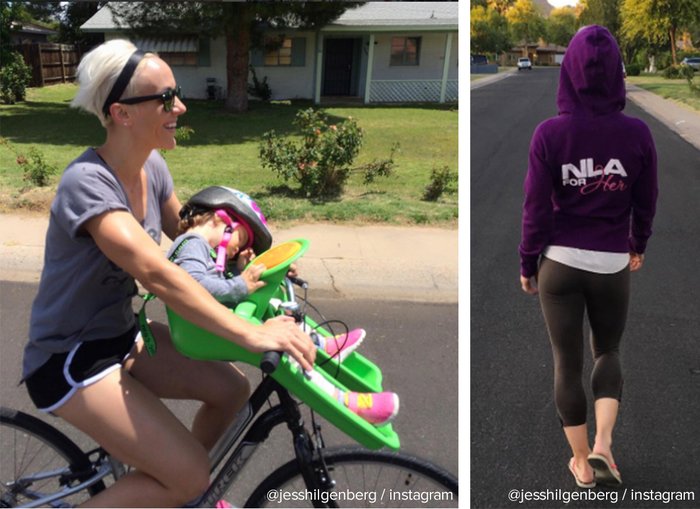It seems like everyone has a love/hate relationship with cardio. We know it's helpful, but in the moment, is it fun? Should it even be fun? Or is it a necessary evil that helps us shed fat, build endurance, and look badass in (or out of) clothing? And which type of cardio is best? Should you do long-slow cardio (LSC), high-intensity interval training (HIIT), take a spin class, dance the pounds away with Zumba, or go 20-seconds on, 10-seconds off with Tabata?
If you're overwhelmed by the number of choices, you're not alone. Physique athletes Jessie Hilgenberg and Theresa Miller and exercise researcher Krissy Kendall, PhD, CSCS are here to give you some much needed clarity about what types of cardio are best for what goals, and how to perform them for maximum effectiveness.
1. Low-Intensity Cardio (aka Long-Slow Cardio, LSC)
It seems that, as of late, low-intensity cardio has fallen out of favor. HIIT, circuit training, and AMRAPs are leading the herd. But there's still a time and place for low-intensity cardio, especially if you want to build endurance, improve aerobic capacity, and, yes, burn fat.
"You can burn a good amount of calories doing low-intensity cardio, and I believe it still has a place in your programming," says Kendall. "It's also a lot easier on your joints and muscles, and it's every bit as good for your heart as more intense options." That makes it the perfect activity for anyone with injuries to rehab, or who hits their other workouts intensely and doesn't want to red-line it on their off-days.
As for active recovery, nothing beats an easy LSC session to increase blood flow, help remove metabolic byproducts from your tissue, and accelerate the healing process. It's also easy to implement. "I like to do low-intensity cardio, to be active with my family," says Hilgenberg. "I put my daughter in her seat on my bike and go for a ride, or I put her in the hiking pack and hit the trails."

LSC is incredibly versatile. Potential activities include walking on a treadmill, cycling outside, or swimming in a lake. As long as you keep your intensity low and your heart rate at 60-75 percent of your maximum, you'll facilitate the best calorie burn and incite metabolic changes, such as an increase in enzymes that help your body utilize carbs and fats for energy.
Kendall recommends that low-intensity cardio should be done after your lifting session or on your active-rest days, and should last 30-45 minutes to build cardiovascular health and muscular and respiratory endurance.
Low-Intensity Cardio Do's and Don'ts
DO: Use it as a warm-up before strength training, but limit the time to 5-10 minutes, max. Anything longer should be done post-workout.
DON'T: Perform a long LSC session before strength training, as it can interfere with strength gains if done before. "When I'm focusing on gaining strength and adding muscle, I like to do low-intensity cardio, especially after leg day," says Miller.
DO: Use it as an active-recovery protocol, and whenever possible, choose an activity you can enjoy with friends and family.
DON'T: Do an LSC activity if it's torturous and you're miserable every minute. "Do the form of cardio you can tolerate best, and that you'll happily repeat, for best results," says Kendall.
2. High-Intensity Cardio (HIIT)
HIIT is the cool kid of the cardio realm. It's fast, efficient, and well-researched. Dozens of studies have proven its benefits, such as building aerobic capacity, improving VO2 max and—the biggie—incinerating fat.
"Multiple studies have shown greater fat loss following HIIT compared to steady-state aerobic exercise," says Kendall. "HIIT appears to increase the body's ability to use fats as energy during exercise and may lead to excess post-exercise oxygen consumption (EPOC), which can help you burn more calories for hours after your workout."
The intensity of the work kicks your metabolism into high gear and creates such an intense metabolic disturbance that it requires lots of calories to recover. This means your body expends energy post-workout repairing the damage and trying to return to homeostasis.
The protocol for HIIT is a measured ratio of high-intensity intervals alternated with rest periods. During the work portion, you work at 85-100 percent max heart rate; during the rest period, you can either stop moving completely or bring the effort down to a lower percentage of your max HR, the intensity of which depends directly on the intensity of the interval just performed.
In other words, if you worked at 95-100 percent effort for the interval, you can drop to zero percent for your rest; if you worked at 85 percent for the interval, you can dip to 60 percent of your max for the rest.

"Typically, the shorter the work interval the harder you should work and the longer you should rest before your next interval," says Kendall.
For example:
- Work @95% effort 30 sec./rest 90 sec.
- Work @90% effort 45 sec./rest 75 sec.
- Work @85% effort 60 sec./rest 60 sec.
The number of intervals you do per workout depends on their length, of course, but Kendall says no HIIT workout should last more than half an hour.
"If you are truly doing high-intensity cardio, there is no way you can do it for 30 minutes," says Kendall. "You should be working at least 85 percent of your max."
HIIT is also a versatile protocol and can done using straight cardio, such as running sprints on a track, a blend of cardio and strength work, like with a CrossFit-style Metcon to improve VO2 max and burn fat, or an AMRAP, where you go through as many rounds as possible of a given movement within a set time frame. Jessie Hilgenberg, for example, likes to push a prowler sled for her HIIT or do uphill sprints, while Theresa Miller prefers jumping rope, stair-stepper intervals, and treadmill HIIT programs.
"The activity that engages the greatest amount of muscle mass and increases the heart rate the most will be the most beneficial for fat loss," says Kendall. "Plus, some people might find the combination of strength training, plyometrics, and cardio to be less monotonous than straight cardio."
High-Intensity Cardio Do's and Don'ts
DO: HIIT after moderate-intensity resistance training or on non-lifting days. "I don't recommend it after a heavy leg or back day, as you may find it difficult to make it through your entire workout," says Kendall.
DON'T: Jump in with both feet if you're a novice exerciser. "You should have a solid base of cardiorespiratory fitness and be free from joint and soft tissue injuries," warns Kendall. "Until then, there's nothing wrong with building up your aerobic base with less intense training. In fact, it's the right thing to do!"
DO: Limit sessions to no more than 20 minutes done 2-3 times per week to prevent negatively impacting your other workouts, and crushing your workout recovery capabilities in general.
DO: Go all-out when performing the intervals, hitting at least 85 percent of your max heart rate. Performing at full capacity without full recovery builds anaerobic capacity, VO2 max, and aerobic power.
Yes, You Can Do Both!
Don't believe the people who treat cardio as an either/or opposition and only advocate one level of intensity. Both training protocols are useful and valid! When planning your weekly workouts, see where you can blend them in and use both for what they're best at. Most importantly, listen to your body.
"If I'm training really hard with weights during one week, I might opt for low-intensity cardio," says Hilgenberg. "If I am short on time and can't get to the gym during the next week, a quick 20-minute HIIT is my go-to solution."
Jessie Hilgenberg’s Weekly Cardio Schedule
- Tuesday: Shoulders, HIIT
- Thursday: HIIT
- Sunday: Low-intensity Cardio, Rest
Theresa Miller’s Weekly Cardio Schedule
- Offseason: Low or Moderate Intensity, 3-5 days a week
- Competitive season: Low or Moderate Intensity, 5 days a week



